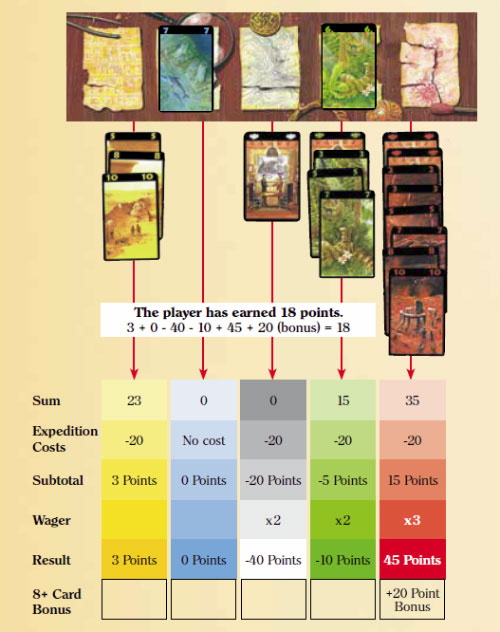

Game Components
- 1 Game board
- 60 Playing cards (45 Expedition cards and 15 Wager cards)
Setup
Place the game board between the two players. It depicts five spaces for discard piles.
Shuffle the 60 playing cards and give eight cards face down to each player. Organize the remaining cards into a draw pile and place them face down beside the game board.
If you play more than one game, have a pen and paper ready to record the ongoing scores.

Object of the Game
Both players' goal is to form expedition routes that - after subtracting the expedition costs - earn them as many discovery points as possible. You set up the expeditions by forming a separate column of cards for each color. The numeric values within a column of cards must increase from card to card.
You can place wager cards at the beginning of each column to multiply a column's value. At the end of the game, the cards in each player's columns are scored.
Video Tutorial
Game turn
The oldest player begins; afterward, the players alternate turns. Each player only places cards on his or her side of the game board.
During your turn, you must first place one of the cards from your hand. Only afterward are you allowed to draw a new card.
Place a Card
Choose a card from your hand. You have two options:
-
Place a Card in One of Your Own Columns
You can use the card to start a new column on your side or to extend one of the columns you have already started. To do this, place the card face up on your side of the game board, below the space for the discard pile of the corresponding color.
You may only place additional cards at the end of a column. Important: Each new card that you place in a column must have a higher value than the most recent card you have placed in this column. Place the cards in a column overlapping each other in such a way that the numbers of all cards are clearly visible.
A wager card may only be placed at the beginning of a column. You may place multiple wager cards in a column. However, as soon as you have placed a number card in a column, you no longer may play any wager cards of this column's color.
-
Discard a Card
If you don't want (or can't) place a card in a column, you must place a card from your hand face up on the game board - more specifically, on the space for the discard pile of the corresponding color. In this manner, five discard piles are formed during game play, one for each color. The cards should be placed on the piles so that only the top card is visible.

Draw a Card
Draw a new card into your hand. You may choose between the top cards of the five discard piles (if cards have been placed there) and the top card of the draw pile.
However, you are not allowed to draw the same card you have just discarded. Once you have drawn a card, your turn ends.
End of the Game

The game ends as soon as a player draws the last card from the draw pile.
Near the game's end, the players may agree to fan out the face-down draw pile a little and count the remaining cards to enable the players to estimate the number of turns before the game ends.
When the game ends, each player's columns of cards are scored. To do this, tally up the values of all cards in a column. From each row's sum, subtract 20 points for the cost of that row's expedition.
Important: If you haven't placed any cards of a certain color, no expedition costs are incurred for this color.
If one, two, or three wager cards were placed at the beginning of a column, multiply the result by 2, 3, or 4, respectively.
Hence, a column can earn you positive or negative points. If you haven't placed any cards of a certain color, you don't earn any points for this color, because there is no column.
Furthermore, each column consisting of at least eight cards earns its owner a bonus of 20 points in addition to the number of points already determined, regardless of how many wager cards the column contains.
Write down the number of points obtained by each player, shuffle all cards, and once again give each player eight cards for the next game. The player who has more points begins.
If after three games you have the highest overall score, you win.
Example:

Continue Reading


